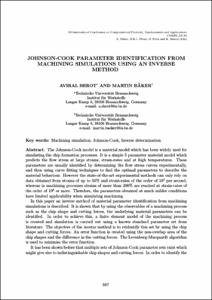Mostra el registre d'ítem simple
Johnson-Cook parameter identification from machining simulations using an inverse method
| dc.contributor.author | Shrot, Aviral |
| dc.contributor.author | Bäker, Martin |
| dc.date.accessioned | 2020-04-20T09:32:27Z |
| dc.date.available | 2020-04-20T09:32:27Z |
| dc.date.issued | 2011 |
| dc.identifier.citation | Shrot, A.; Bäker, M. Johnson-Cook parameter identification from machining simulations using an inverse method. A: COMPLAS XI. "COMPLAS XI : proceedings of the XI International Conference on Computational Plasticity : fundamentals and applications". CIMNE, 2011, p. 887-898. |
| dc.identifier.isbn | 978-84-89925-73-1 |
| dc.identifier.uri | http://hdl.handle.net/2117/183979 |
| dc.description.abstract | The Johnson-Cook model is a material model which has been widely used for simulating the chip formation processes. It is a simple 5 parameter material model which predicts the flow stress at large strains, strain-rates and at high temperatures. These parameters are usually identified by determining the flow stress curves experimentally, and then using curve fitting techniques to find the optimal parameters to describe the material behaviour. However the state-of-the-art experimental methods can only rely on data obtained from strains of up to 50% and strain-rates of the order of 103 per second, whereas in machining processes strains of more than 200% are reached at strain-rates of the order of 106 or more. Therefore, the parameters obtained at much milder conditions have limited applicability when simulating machining. In this paper an inverse method of material parameter identification from machining simulations is described. It is shown that by using the observables of a machining process such as the chip shape and cutting forces, the underlying material parameters can be identified. In order to achieve this, a finite element model of the machining process is created and simulation is carried out using a known standard parameter set from literature. The objective of the inverse method is to reidentify this set by using the chip shape and cutting forces. An error function is created using the non-overlap area of the chip shapes and the difference in the cutting forces. The Levenberg-Marquardt algorithm is used to minimise the error function. It has been shown before that multiple sets of Johnson-Cook parameter sets exist which might give rise to indistinguishable chip shapes and cutting forces. In order to identify the parameter set uniquely, simulations are performed at widely varying cutting conditions such as differing rake angles, cutting speeds and non-adiabatic conditions. Thus, material parameters which represent the material behaviour over a wide range can be identified. |
| dc.format.extent | 12 p. |
| dc.language.iso | eng |
| dc.publisher | CIMNE |
| dc.subject | Àrees temàtiques de la UPC::Matemàtiques i estadística::Anàlisi numèrica::Mètodes en elements finits |
| dc.subject.lcsh | Finite element method |
| dc.subject.lcsh | Plasticity -- Mathematical models |
| dc.subject.lcsh | Plasticity |
| dc.subject.other | Machining simulation, Johnson-Cook, Inverse determination |
| dc.title | Johnson-Cook parameter identification from machining simulations using an inverse method |
| dc.type | Conference report |
| dc.subject.lemac | Elements finits, Mètode dels |
| dc.subject.lemac | Plasticitat -- Models matemàtics |
| dc.subject.lemac | Plasticitat |
| dc.rights.access | Open Access |
| local.citation.contributor | COMPLAS XI |
| local.citation.publicationName | COMPLAS XI : proceedings of the XI International Conference on Computational Plasticity : fundamentals and applications |
| local.citation.startingPage | 887 |
| local.citation.endingPage | 898 |


